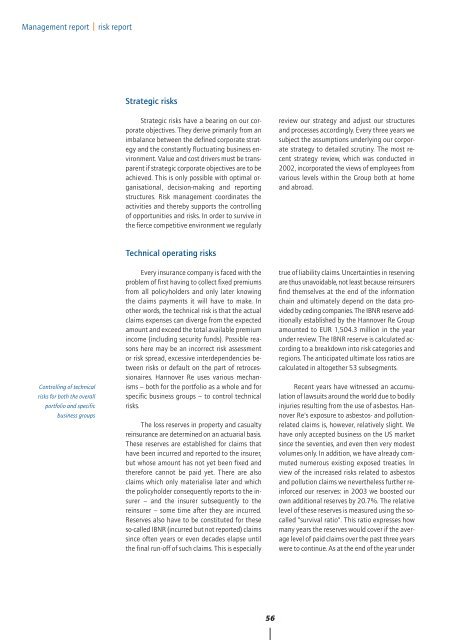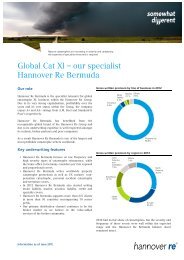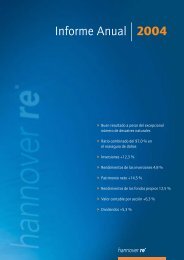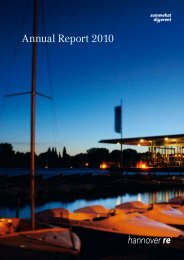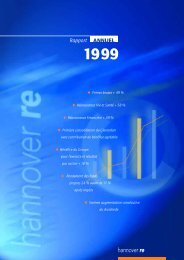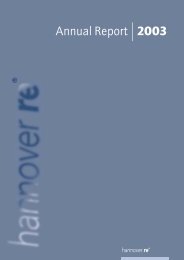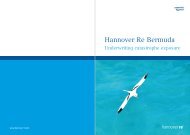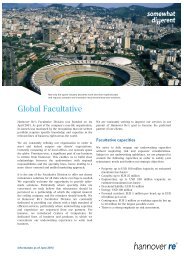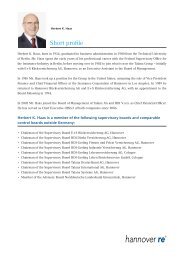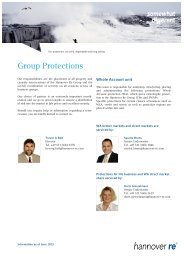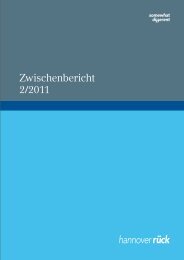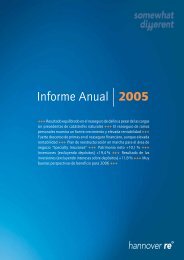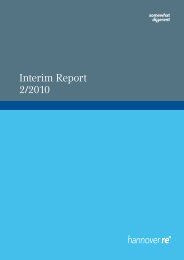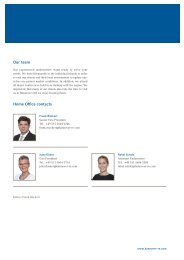Annual Report 2003 - Hannover Re
Annual Report 2003 - Hannover Re
Annual Report 2003 - Hannover Re
You also want an ePaper? Increase the reach of your titles
YUMPU automatically turns print PDFs into web optimized ePapers that Google loves.
Management report<br />
risk report<br />
Strategic risks<br />
Strategic risks have a bearing on our corporate<br />
objectives. They derive primarily from an<br />
imbalance between the defined corporate strategy<br />
and the constantly fluctuating business environment.<br />
Value and cost drivers must be transparent<br />
if strategic corporate objectives are to be<br />
achieved. This is only possible with optimal organisational,<br />
decision-making and reporting<br />
structures. Risk management coordinates the<br />
activities and thereby supports the controlling<br />
of opportunities and risks. In order to survive in<br />
the fierce competitive environment we regularly<br />
review our strategy and adjust our structures<br />
and processes accordingly. Every three years we<br />
subject the assumptions underlying our corporate<br />
strategy to detailed scrutiny. The most recent<br />
strategy review, which was conducted in<br />
2002, incorporated the views of employees from<br />
various levels within the Group both at home<br />
and abroad.<br />
Controlling of technical<br />
risks for both the overall<br />
portfolio and specific<br />
business groups<br />
Technical operating risks<br />
Every insurance company is faced with the<br />
problem of first having to collect fixed premiums<br />
from all policyholders and only later knowing<br />
the claims payments it will have to make. In<br />
other words, the technical risk is that the actual<br />
claims expenses can diverge from the expected<br />
amount and exceed the total available premium<br />
income (including security funds). Possible reasons<br />
here may be an incorrect risk assessment<br />
or risk spread, excessive interdependencies between<br />
risks or default on the part of retrocessionaires.<br />
<strong>Hannover</strong> <strong>Re</strong> uses various mechanisms<br />
– both for the portfolio as a whole and for<br />
specific business groups – to control technical<br />
risks.<br />
The loss reserves in property and casualty<br />
reinsurance are determined on an actuarial basis.<br />
These reserves are established for claims that<br />
have been incurred and reported to the insurer,<br />
but whose amount has not yet been fixed and<br />
therefore cannot be paid yet. There are also<br />
claims which only materialise later and which<br />
the policyholder consequently reports to the insurer<br />
– and the insurer subsequently to the<br />
reinsurer – some time after they are incurred.<br />
<strong>Re</strong>serves also have to be constituted for these<br />
so-called IBNR (incurred but not reported) claims<br />
since often years or even decades elapse until<br />
the final run-off of such claims. This is especially<br />
true of liability claims. Uncertainties in reserving<br />
are thus unavoidable, not least because reinsurers<br />
find themselves at the end of the information<br />
chain and ultimately depend on the data provided<br />
by ceding companies. The IBNR reserve additionally<br />
established by the <strong>Hannover</strong> <strong>Re</strong> Group<br />
amounted to EUR 1,504.3 million in the year<br />
under review. The IBNR reserve is calculated according<br />
to a breakdown into risk categories and<br />
regions. The anticipated ultimate loss ratios are<br />
calculated in altogether 53 subsegments.<br />
<strong>Re</strong>cent years have witnessed an accumulation<br />
of lawsuits around the world due to bodily<br />
injuries resulting from the use of asbestos. <strong>Hannover</strong><br />
<strong>Re</strong>'s exposure to asbestos- and pollutionrelated<br />
claims is, however, relatively slight. We<br />
have only accepted business on the US market<br />
since the seventies, and even then very modest<br />
volumes only. In addition, we have already commuted<br />
numerous existing exposed treaties. In<br />
view of the increased risks related to asbestos<br />
and pollution claims we nevertheless further reinforced<br />
our reserves: in <strong>2003</strong> we boosted our<br />
own additional reserves by 20.7%. The relative<br />
level of these reserves is measured using the socalled<br />
"survival ratio". This ratio expresses how<br />
many years the reserves would cover if the average<br />
level of paid claims over the past three years<br />
were to continue. As at the end of the year under<br />
56


